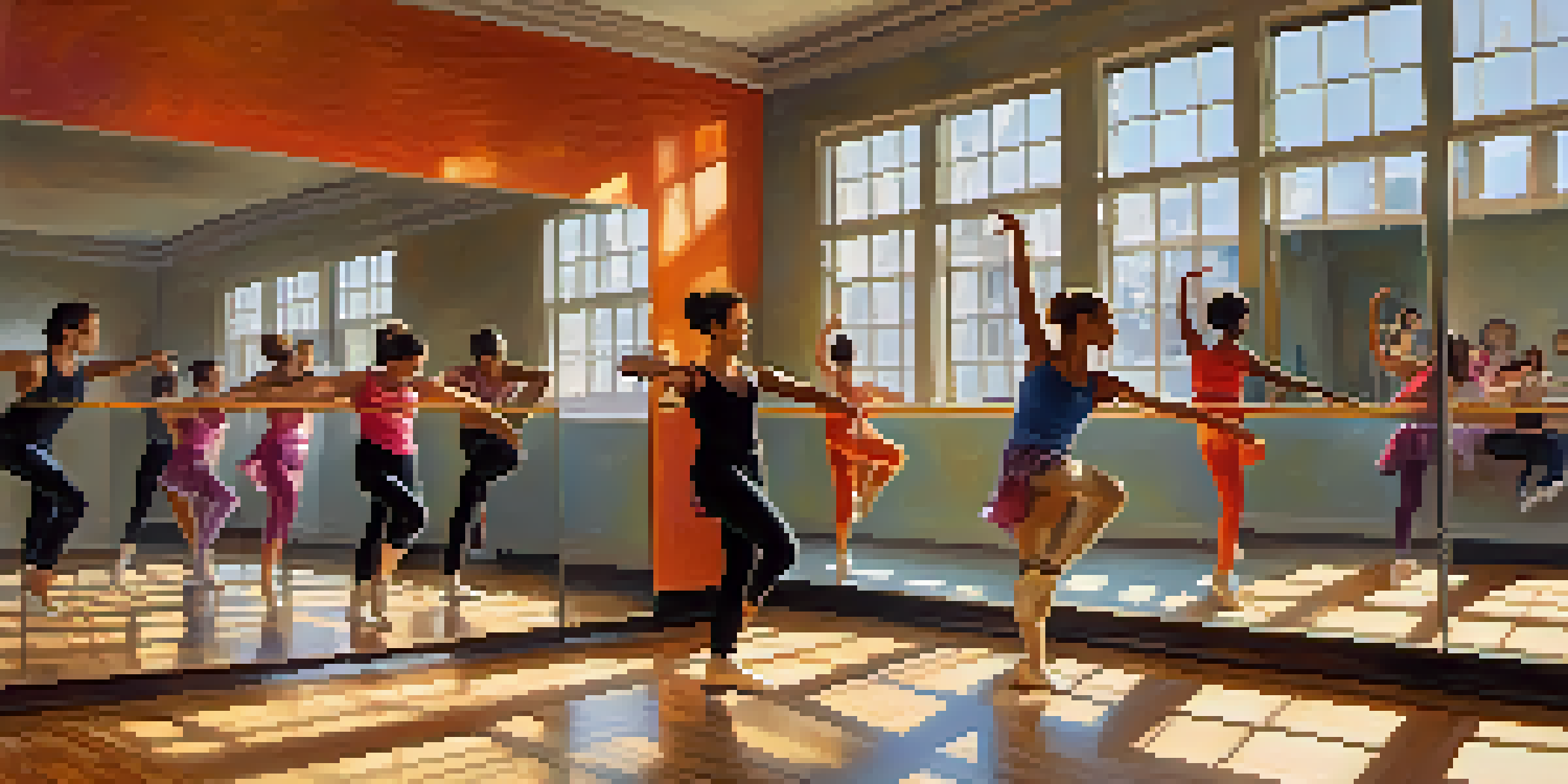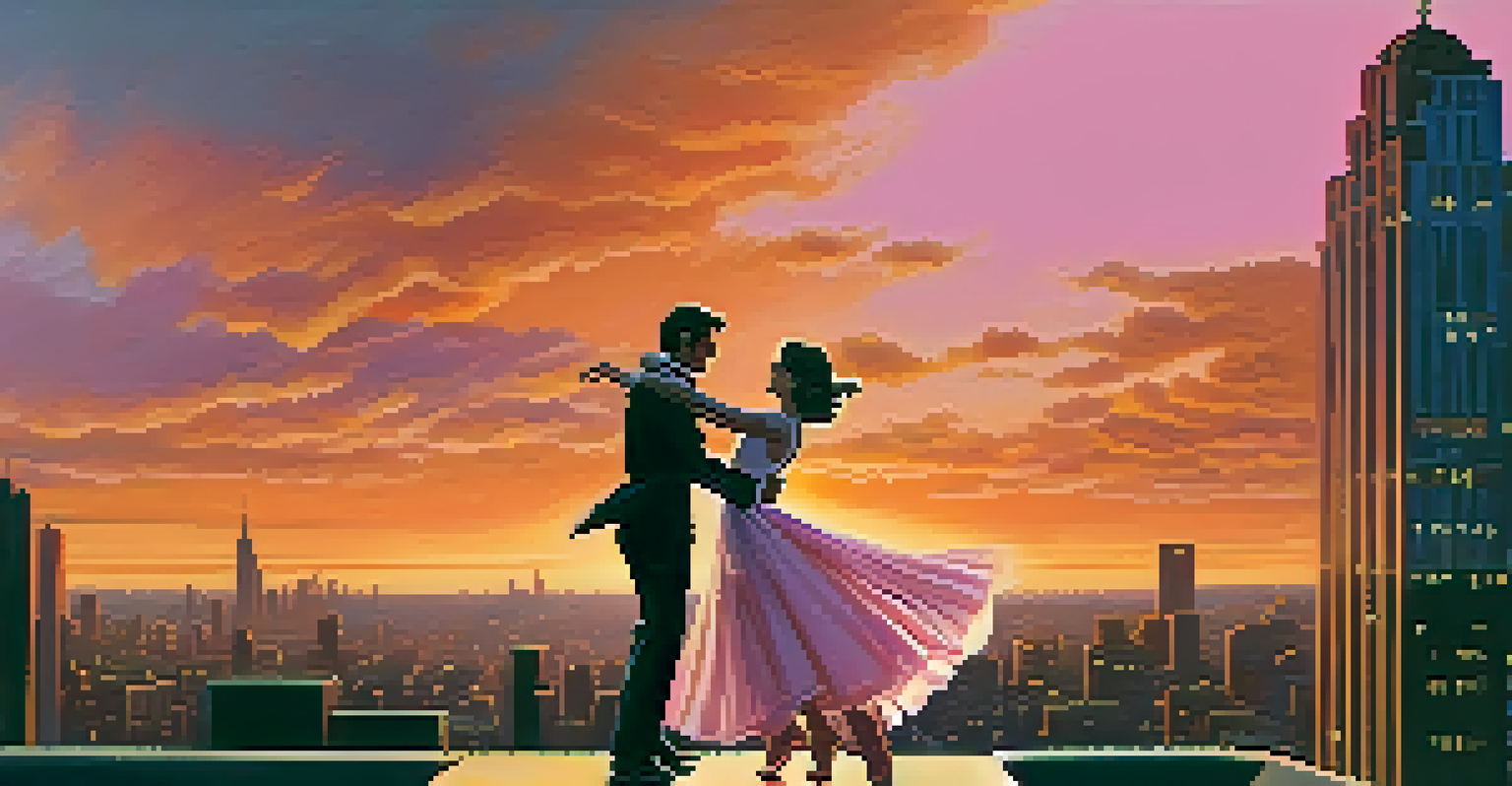The Role of Choreography in Bridging Dance and Film Art

Understanding Choreography: The Heart of Movement
Choreography is the art of creating sequences of movements, often for dance. It serves as a blueprint, guiding dancers in their performances. Just as a writer structures a story, a choreographer maps out the physical narrative, ensuring each movement contributes to the overall theme.
Dance is the hidden language of the soul.
In both dance and film, choreography shapes how stories are told. It transforms simple movements into powerful expressions of emotion and narrative. This connection between the two art forms illustrates how choreography can elevate the viewer's experience.
Ultimately, understanding choreography provides insight into the language of movement. It opens up a world where dance and film intertwine, enhancing both mediums. Recognizing this relationship allows audiences to appreciate the complexity and beauty of storytelling through movement.
The Historical Connection Between Dance and Film
The relationship between dance and film dates back to the early 20th century. Pioneering filmmakers like Busby Berkeley showcased dance on screen, blending choreography with cinematic techniques. This fusion created a new form of entertainment that captivated audiences and set the stage for future collaborations.

As cinema evolved, so did the role of choreography within it. Films began to feature more elaborate dance sequences, showcasing the skills of dancers and choreographers alike. This evolution not only enriched the storytelling but also broadened the appeal of both dance and film as art forms.
Choreography as Narrative Blueprint
Choreography serves as a crucial framework that transforms movement into a compelling narrative, enhancing emotional expression in both dance and film.
The historical context highlights how choreography has always been integral to film. From musicals to dance dramas, choreographers have played a vital role in shaping cinematic experiences. Understanding this history allows us to appreciate the ongoing dialogue between these two vibrant art forms.
Choreography Enhancing Storytelling in Film
Choreography plays a crucial role in enhancing storytelling in film. Through movement, characters can express emotions and intentions that dialogue alone cannot convey. This visual language adds depth to the narrative, allowing audiences to connect with the characters on a more visceral level.
Choreography is the art of movement, a narrative in itself that speaks without words.
For instance, in a romantic film, a well-choreographed dance can symbolize the growing bond between two characters. The way they move together can reflect their emotional journey, making the story more impactful. Choreography thus acts as a bridge, linking the audience to the characters' experiences.
By integrating choreography into film, creators can elevate their storytelling to new heights. It provides a dynamic way to engage viewers, creating memorable moments that linger long after the credits roll. This synergy between choreography and storytelling is what makes film a powerful medium.
The Role of Choreographers in Film Production
Choreographers play a vital role in the film production process, working closely with directors to bring movement to life. They translate the director's vision into expressive choreography that enhances the film's narrative. This collaboration ensures that dance sequences are not just visually stunning but also serve a purpose within the story.
Moreover, choreographers are responsible for teaching the dance to the actors, adapting movements to fit their abilities. This requires a deep understanding of both dance and character development. By doing so, they ensure that the choreography feels authentic and integral to the film's overall message.
Historical Fusion of Dance and Film
The historical connection between dance and film highlights how choreography has evolved to become an integral part of cinematic storytelling since the early 20th century.
In essence, choreographers act as storytellers through movement, adding layers to the cinematic experience. Their expertise not only amplifies the visual appeal but also deepens the emotional resonance of the film. This highlights the importance of their role in bridging dance and film art.
Iconic Dance Scenes That Define Film History
Throughout film history, iconic dance scenes have left an indelible mark on audiences. Think of the exhilarating dance numbers in classics like 'Singin' in the Rain' or 'West Side Story.' These scenes not only showcased incredible choreography but also pushed the boundaries of storytelling in cinema.
These memorable moments illustrate how choreography can enhance character development and plot progression. For instance, in 'Dirty Dancing,' the final dance symbolizes personal growth and the culmination of a romantic journey. Such scenes remain etched in our memories, proving the lasting impact of choreography in film.
By studying these iconic moments, we can see how choreography can define a film's legacy. They serve as benchmarks for creativity and innovation, inspiring future filmmakers and choreographers alike. This enduring influence showcases the vital relationship between dance and film art.
Modern Trends in Dance Film Collaborations
In recent years, we've seen a resurgence of dance in film, with innovative collaborations emerging across genres. Filmmakers are increasingly recognizing the power of movement to tell stories in fresh ways. This trend has led to a new wave of dance films that blend various styles and narratives, captivating audiences worldwide.
Platforms like Netflix and YouTube have also played a significant role in this evolution. They provide a space for choreographers and filmmakers to experiment with new concepts, reaching a broader audience. This accessibility has fostered a vibrant community where dance and film can thrive together.
Future Trends in Dance Film
The future of choreography in film is set to explore innovative technologies and diverse cultural influences, promising exciting new storytelling possibilities.
As modern trends continue to unfold, the relationship between dance and film will likely grow even stronger. With technology and creativity combining, we can look forward to exciting new forms of storytelling. This evolution reaffirms choreography's essential role in bridging these two dynamic art forms.
The Future of Choreography in Film Art
Looking ahead, the future of choreography in film art is brimming with possibilities. As technology advances, choreographers are exploring virtual reality and motion capture, expanding how movement can be represented on screen. This innovation opens up new avenues for storytelling, allowing for even more creative expression.
Additionally, as diverse voices emerge in the film industry, we can expect to see choreography that reflects a wider range of cultural influences. This diversity enriches the narrative landscape, providing audiences with fresh perspectives and experiences. It underscores the importance of representation in both dance and film.

Ultimately, the future of choreography in film promises to be an exciting journey. By continuing to push boundaries and embrace new ideas, choreographers will play a crucial role in shaping the narratives of tomorrow. This ongoing evolution reinforces the powerful connection between dance and film art.